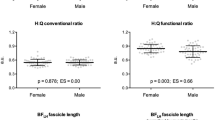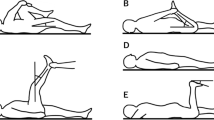Abstract
Purpose
To demonstrate the potential for a simple clinical test of hamstring muscle strength to identify susceptibility to muscle strain injury.
Methods
A single-case design was used; specifically, an elite-level male Australian Rules football player performed bilateral isometric maximum voluntary contractions of the hamstring muscles on a weekly basis for a period of 5 weeks preceding a right hamstring muscle strain injury.
Results
Minimal asymmetry (no greater than ±1.2% difference) was evident in the hamstring isometric maximum voluntary contractions during the first 4 weeks, but 5 days prior to injury, the right hamstring isometric maximum voluntary contraction was reduced by 10.9% compared to the left.
Conclusion
Measuring asymmetry in isometric maximum voluntary contractions of the hamstring muscles may be a useful clinical test to identify susceptibility to muscle strain injury.



Similar content being viewed by others
References
Arnason A, Andersen TE, Holme I, Engebretsen L, Bahr R (2008) Prevention of hamstring strains in elite soccer: an intervention study. Scand J Med Sci Sports 18:40–48
Askling C, Karlsson J, Thorstensson A (2003) Hamstring injury occurrence in elite soccer players after preseason strength training with eccentric overload. Scand J Med Sci Sports 13:244–250
Bohannon RW (1997) Reference values for extremity muscle strength obtained by hand-held dynamometry from adults aged 20 to 79 years. Arch Phys Med Rehabil 78:26–32
Croisier J-L, Ganteaume S, Binet J, Genty M, Ferret J-M (2008) Strength imbalances and prevention of hamstring injury in professional soccer players. Am J Sports Med 36:1469–1475
Ekstrand J, Hägglund M, Waldén M (2010) Injury incidence and injury patterns in professional football—the UEFA injury study. Br J Sports Med (in press). doi:10.1136/bjsm.2009.060582; PMID: 19553225
Engebretsen AH, Myklebust G, Holme I, Engebretsen L, Bahr R (2010) Intrinsic risk factors for hamstring injuries among male soccer players: a prospective cohort study. Am J Sports Med 38:1147–1153
Gabbe BJ, Bennell KL, Finch CF, Wajswelner H, Orchard JW (2006) Predictors of hamstring injury at the elite level of Australian football. Scand J Med Sci Sports 16:7–13
Herzog W, Read LJ (1993) Lines of action and moment arms of the major force-carrying structures crossing the human knee joint. J Anat 182:213–230
Koulouris G, Connell DA, Brukner P, Schneider-Kolsky M (2007) Magnetic resonance imaging parameters for assessing risk of recurrent hamstring injuries in elite athletes. Am J Sports Med 35:1500–1506
Kraemer R, Knobloch K (2009) A soccer-specific balance training program for hamstring muscle and patellar and achilles tendon injuries: an intervention study in premier league female soccer. Am J Sports Med 37:1384–1393
Landes S, Nyland J, Elmlinger B, Tillett E, Caborn D (2010) Knee flexor strength after ACL reconstruction: comparison between hamstring autograft, tibialis anterior allograft, and non-injured controls. Knee Surg Sports Traumatol Arthrosc 18:317–324
Malliaras P, Hogan A, Nawrocki A, Crossley K, Schache A (2009) Hip flexibility and strength measures: reliability and association with athletic groin pain. Br J Sports Med 43:739–744
Orchard J, Seward H (2002) Epidemiology of injuries in the Australian Football League, seasons 1997–2000. Br J Sports Med 36:39–45
Orchard JW (1998) Recurrent hamstring injury in Australian Football. Med Sci Sports Exerc 30:S52
Orchard JW (2001) Intrinsic and extrinsic risk factors for muscle strains in Australian football. Am J Sports Med 29:300–303
Phillips BA, Lo SK, Mastaglia FL (2000) Muscle force measured using “break” testing with a hand-held myometer in normal subjects aged 20 to 69 years. Arch Phys Med Rehabil 81:653–661
Scott DA, Bond EQ, Sisto SA, Nadler SF (2004) The intra- and inter-rater reliability of hip muscle strength assessments using a handheld versus a portable dynamometer anchoring station. Arch Phys Med Rehabil 85:598–603
Sherry MA, Best TM (2004) A comparison of 2 rehabilitation programs in the treatment of acute hamstring strains. J Orthop Sports Phys Ther 34:116–125
Sole G, Milosavljevic S, Sullivan SJ, Nicholson H (2008) Running-related hamstring injuries: a neuromuscular approach. Phys Ther Rev 13:102–110
Sugiura Y, Saito T, Sakuraba K, Sakuma K, Suzuki E (2008) Strength deficits identified with concentric action of the hip extensors and eccentric action of the hamstrings predispose to hamstring injury in elite sprinters. J Orthop Sports Phys Ther 38:457–464
Trudelle-Jackson E, Jackson AW, Frankowski CM, Long KM, Meske NB (1994) Interdevice reliability and validity assessment of the Nicholas hand-held dynamometer. J Orthop Sports Phys Ther 20:302–306
Verrall GM, Slavotinek JP, Barnes PG, Fon GT, Spriggins AJ (2001) Clinical risk factors for hamstring strain injury: a prospective study with correlation of injury by magnetic resonance imaging. Br J Sports Med 35:435–440
Wikholm JB, Bohannon RW (1991) Hand-held dynamometer measurements: tester strength makes a difference. J Orthop Sports Phys Ther 13:191–198
Woods C, Hawkins RD, Maltby S, Hulse M, Thomas A, Hodson A (2004) The football association medical research programme: an audit of injuries in professional football—analysis of hamstring injuries. Br J Sports Med 38:36–41
Yeung SS, Suen AMY, Yeung EW (2009) A prospective cohort study of hamstring injuries in competitive sprinters: preseason muscle imbalance as a possible risk factor. Br J Sports Med 43:589–594
Author information
Authors and Affiliations
Corresponding author
Rights and permissions
About this article
Cite this article
Schache, A.G., Crossley, K.M., Macindoe, I.G. et al. Can a clinical test of hamstring strength identify football players at risk of hamstring strain?. Knee Surg Sports Traumatol Arthrosc 19, 38–41 (2011). https://doi.org/10.1007/s00167-010-1221-2
Received:
Accepted:
Published:
Issue Date:
DOI: https://doi.org/10.1007/s00167-010-1221-2




